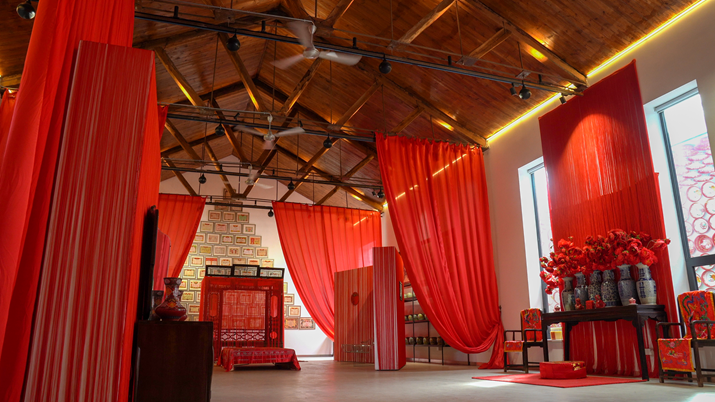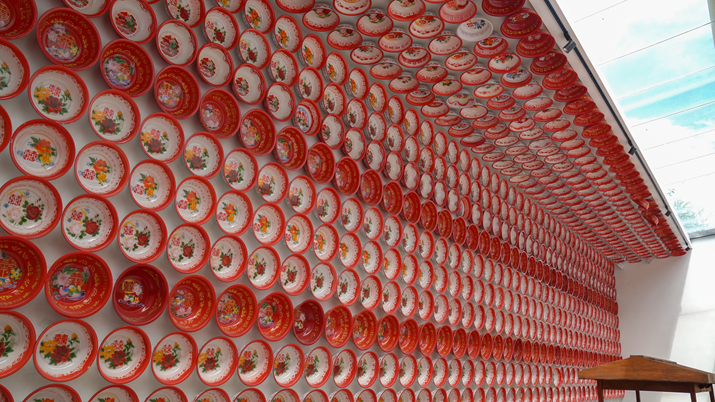| Lifestyle |
| The most auspicious of all Chinese motifs through one ballerina's eyes | |
|
|
 Inside shuang xi collector Wang Yanping's studio in Beijing's Shunyi District on August 19 (ZHANG WEI)
The delight of rain after a long drought, meeting an old friend far away from home, enjoying a night of wedding festivities, and passing the imperial examination. These are what the ancient Chinese called the four great xi in life. The Chinese character xi means happiness. But can one collect happiness? According to Wang Yanping, a shuang xi collector, the answer to that question is a resounding "yes!" As of today, Wang has collected thousands of antiques bearing the elaborate Chinese character, including silverware, copperware, woodware and marriage certificates from times long gone. Joining two xi characters side by side to make a shuang xi (double xi) is mostly used as a motif channeling happiness and good fortune that often appears on traditional decorative items, most commonly seen on Chinese wedding attire. "Shuang xi refers to two happy things occurring simultaneously, signifying mutual affection," Wang told Beijing Review. Legend has it that Wang Anshi, a famous prime minister and scholar in the Song Dynasty (960-1279), was informed he'd passed the imperial examination on his wedding day—a double blessing. He was in such high spirits that he wrote a giant shuang xi on a square piece of paper, and his newly created motif soon became a hit among the masses. "The image became a wedding ceremony staple popular to the extent that without the presence of shuang xi, there was no qualified wedding. And this thought still lives on today," Wang said. The ubiquitous pasting of shuang xi indeed remains a traditional Chinese wedding custom. Kitschy captivation In the late 1990s, Wang and a friend would frequently explore Beijing's Panjiayuan antique market. After two years of hunting through the stalls looking for hidden treasures, in 1999, Wang spotted the character on a jade tablet and was captivated by its beauty. "I was a ballerina. There's a connection between ballet and my falling in love with shuang xi," Wang said. The two xis in her eyes are performing a pas de deux, a dance duet in which two dancers, typically a male and a female, perform ballet steps together. "I thought it was the most beautiful and auspicious Chinese character," Wang said. And it was at that moment Wang declared to her friends, "From now on, I will be collecting items with shuang xi." To gather these scattered pieces of joy, Wang made her way through cities, flea markets and antique shops nationwide, her tracks covering zigzag narrow city lanes known as hutongs, megacity malls and vast rural fields. Many a tale and scenery accompanied her along the way. Whenever Wang was looking for shuang xi at a store, she would ask if they had any items bearing the motif. One time, a store manager said "no," but then Wang suddenly found a minute one sitting on a ring—even the manager hadn't noticed it. "I have this feeling that shuang xi and I are like two magnets," Wang said. "I look for it and it finds me." Every object featuring the character tells an as-of-yet unknown story about happiness. Wang's studio in Beijing's Shunyi District has a wall decorated with enamel washbasins, all bearing the shuang xi image. These washbasins were once an inextricable part of a bride's dowry and undoubtedly hold many stories. "It is kitschy. Kitschy yet beautiful. Its beauty is, in my opinion, the most vivid in traditional Chinese culture," Wang explained. Over the centuries, shuang xi would be on every item gifted to newlyweds, for example, a brush, a simple iron, or a washboard. Back then, shuang xi was still revered and valued. Many of these old customary "carriers" are hard to come by today, their traditional gifting slowly fading into oblivion. "They're a symbol of days long gone and embody the spirit of those times," Wang added. "But… the motif still brings good luck to newlyweds," Wang said, adding this is simply the Chinese aesthetic of life. The passion the Chinese invest in the culture of joy comes from deep within and beholding the sight of shuang xi produces a feeling of joy, delight, and being blessed, according to Wang.  Enamel washbasins featuring the shuang xi motif collected in Wang Yanping's studio in Beijing's Shunyi District on August 19 (ZHANG WEI)
Telling the story In recent years, Wang has hosted several exhibitions on shuang xi culture. The showings displayed the finest pieces from her collection, a project spanning several decades. Collectors, entrepreneurs, artists and many other interested visitors all came to take a look. "Collecting is a hobby I would like to continue. I hope my hard work will enable more people at home and abroad to get in touch with shuang xi culture, and export it to the wider world," Wang said. In modern times, with so many influences pouring in from all over the world, getting China's young adults to learn more about and better understand their traditional culture is no easy feat. The shuang xi motif, for example, is still widely used in wedding ceremonies, but one rarely sees it on everyday products anymore. "The fervor the Chinese pour into their own culture can draw you in immediately," Wang said. She firmly believes the youth will eventually return to its own cultural roots. Aside from her exhibitions, Wang has also tried her hand at creating shuang xi cultural products. She published a book detailing the story behind her vast collection and produced calendars and notebooks containing pictures of her beloved character-carrying antiques. "We need more creativity, fusing modern elements with traditional ones," Wang said, only this way will young people be more likely to love the different aspects of their inherent culture. Like a ballerina pushing herself up onto her toes with a sense of innate strength and grace, this one small elegant character, shuang xi, can lift itself onto the world stage to tell its audiences about China's philosophy of life and the aesthetic values of the nation's people. (Print Edition Title: The Joy of Collecting… Joy!) Copyedited by Elsbeth van Paridon Comments to taoxing@cicgamericas.com |
|
||||||
|
||||||||||||||||||||||||||||
|